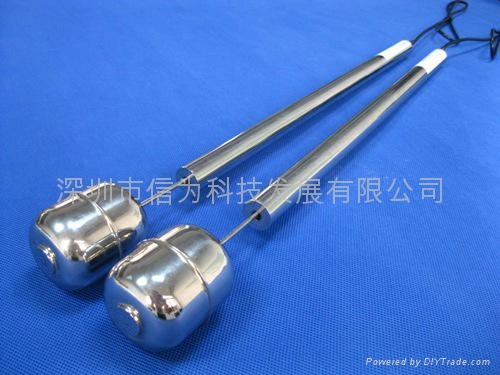Soway浮子式LVDT位移傳感器
A common way of measuring the level of liquid in a tank places a low-pressure sensor at the bottom. The pressure readout is the product of the liquid column height times the density of the liquid. As long as liquid density remains constant, the measured pressure is directly proportional to the liquid level. This method works with all low-vapor-pressure, low-viscosity liquids and, of course, water.
傳統的測量罐體內液位的高度變化的方法,通常是在罐體底部安裝一只壓力傳感器,讀取的壓力值即是液面高度與液體密度之積。只要液體的密度不變,測出的壓力將與液位高度成正比。這種方法很適用於檢測低氣壓、低粘度的液體,也就是水。
The difficulty lies in inserting the pressure sensor at the right location in the tank to make the measurement. The sensing of lowdensity liquids or of small level changes may require special, lowpressure transducers that are expensive and hard to find. The use of a float attached to a nearly friction-free linear-variable-displacement transducer (LVDT) offers a reasonable replacement. LVDTs can measure liquid-level changes from a few inches to several feet.
問題在於,將液壓傳感器裝在罐內合適的位置檢測液位高度,並不簡單。檢測有些低密度或者高度變化細微的液體,還需配置特殊的液壓傳感器,該產品往往是價格不菲且不易尋找。在無滑動觸點的差動變壓式(LVDT)位移傳感器的探杆上連接一個浮球,就可以測量1英吋(毫米級)到數英呎(分米)的液位高度,達到微米級的精度,從而提供了一個很好的解決方案。
In the typical LVDT level sensor, a stainless-steel float coupled to a nonmagnetic stainless-steel rod is attached to the high-permeability armature core of the LVDT. The 4 to 20-mA loop-powered LVDT position transmitter senses the position of the core and, thus, the level of the float. Sensitivity to the change in level depends on the length of LVDT. The most common units measure level changes from 0 to 2, 12, or 20 in. (50, 300, or 500 mm) with the shorter lengths providing greatest sensitivity.
標準的LVDT液位傳感器,是將LVDT電樞鐵芯通過非磁不鏽鋼連杆連接到浮球。LVDT液位傳感器通過檢測鐵芯的位置變化,進而檢測到浮球的液位高度,輸出4-20MA的標準工業信號。這類LVDT原理的液位傳感器的量程範圍通常是零到2英吋、12英吋、20英吋(50毫米、300毫米、500毫米)等幾種規格。量程越小,精度也就越高(精度=滿量程*線性度)
As water level changes, the float moves up or down, bringing the LVDT core with it. A threaded stainless-steel rod protrudes from the other end of the core. It carries two jam nuts to adjust the position sensor output at the desired low water level. The nuts also prevent the core from falling out of the LVDT housing if the liquid level drops too low.
隨着液位的變化,浮球上下移動,LVDT的鐵芯也隨之浮動。在鐵芯末端突出一根不鏽鋼螺杆, 上面配有兩隻安全螺母,一個用來調節低水位時位置傳感器的輸出 (即零點), 另一個防止液位降得過低時鐵芯從LVDT的主體中脫落。
A nonmagnetic clamp block attaches the stainless-steel body of the LVDT to a flat hook. The hook hangs the level-sensor assembly over the tank edge.
LVDT通過一塊溫度膨脹係數小的非磁夾具懸挂在扁平鉤上,借此固定在罐體邊緣。
Core position is sensed using magnetic induction. In fact, the electronics of the LVDT are hermetically sealed inside its stainless-steel housing. A Teflon liner inside the bore minimizes any friction to core motion. There are no springs to fatigue or parts to wear out. And, LVDT transmitters come in agency-listed versions for use in Class 1, Div. 1 or 2, or Zone 2 hazardous locations.
LVDT的鐵芯定位是運用了電磁感應原理。事實上,LVDT的電子電路是完全密封在不鏽鋼殼體內的。不鏽鋼管內的鐵氟龍襯墊避免了鐵芯在運動中的摩擦。裡面也沒有彈簧或其他可損部件。因而,LVDT位移傳感器已位列EX(ia)IIA防爆級別。
傳統的測量罐體內液位的高度變化的方法,通常是在罐體底部安裝一只壓力傳感器,讀取的壓力值即是液面高度與液體密度之積。只要液體的密度不變,測出的壓力將與液位高度成正比。這種方法很適用於檢測低氣壓、低粘度的液體,也就是水。
The difficulty lies in inserting the pressure sensor at the right location in the tank to make the measurement. The sensing of lowdensity liquids or of small level changes may require special, lowpressure transducers that are expensive and hard to find. The use of a float attached to a nearly friction-free linear-variable-displacement transducer (LVDT) offers a reasonable replacement. LVDTs can measure liquid-level changes from a few inches to several feet.
問題在於,將液壓傳感器裝在罐內合適的位置檢測液位高度,並不簡單。檢測有些低密度或者高度變化細微的液體,還需配置特殊的液壓傳感器,該產品往往是價格不菲且不易尋找。在無滑動觸點的差動變壓式(LVDT)位移傳感器的探杆上連接一個浮球,就可以測量1英吋(毫米級)到數英呎(分米)的液位高度,達到微米級的精度,從而提供了一個很好的解決方案。
In the typical LVDT level sensor, a stainless-steel float coupled to a nonmagnetic stainless-steel rod is attached to the high-permeability armature core of the LVDT. The 4 to 20-mA loop-powered LVDT position transmitter senses the position of the core and, thus, the level of the float. Sensitivity to the change in level depends on the length of LVDT. The most common units measure level changes from 0 to 2, 12, or 20 in. (50, 300, or 500 mm) with the shorter lengths providing greatest sensitivity.
標準的LVDT液位傳感器,是將LVDT電樞鐵芯通過非磁不鏽鋼連杆連接到浮球。LVDT液位傳感器通過檢測鐵芯的位置變化,進而檢測到浮球的液位高度,輸出4-20MA的標準工業信號。這類LVDT原理的液位傳感器的量程範圍通常是零到2英吋、12英吋、20英吋(50毫米、300毫米、500毫米)等幾種規格。量程越小,精度也就越高(精度=滿量程*線性度)
As water level changes, the float moves up or down, bringing the LVDT core with it. A threaded stainless-steel rod protrudes from the other end of the core. It carries two jam nuts to adjust the position sensor output at the desired low water level. The nuts also prevent the core from falling out of the LVDT housing if the liquid level drops too low.
隨着液位的變化,浮球上下移動,LVDT的鐵芯也隨之浮動。在鐵芯末端突出一根不鏽鋼螺杆, 上面配有兩隻安全螺母,一個用來調節低水位時位置傳感器的輸出 (即零點), 另一個防止液位降得過低時鐵芯從LVDT的主體中脫落。
A nonmagnetic clamp block attaches the stainless-steel body of the LVDT to a flat hook. The hook hangs the level-sensor assembly over the tank edge.
LVDT通過一塊溫度膨脹係數小的非磁夾具懸挂在扁平鉤上,借此固定在罐體邊緣。
Core position is sensed using magnetic induction. In fact, the electronics of the LVDT are hermetically sealed inside its stainless-steel housing. A Teflon liner inside the bore minimizes any friction to core motion. There are no springs to fatigue or parts to wear out. And, LVDT transmitters come in agency-listed versions for use in Class 1, Div. 1 or 2, or Zone 2 hazardous locations.
LVDT的鐵芯定位是運用了電磁感應原理。事實上,LVDT的電子電路是完全密封在不鏽鋼殼體內的。不鏽鋼管內的鐵氟龍襯墊避免了鐵芯在運動中的摩擦。裡面也沒有彈簧或其他可損部件。因而,LVDT位移傳感器已位列EX(ia)IIA防爆級別。
